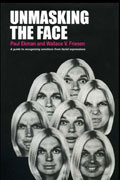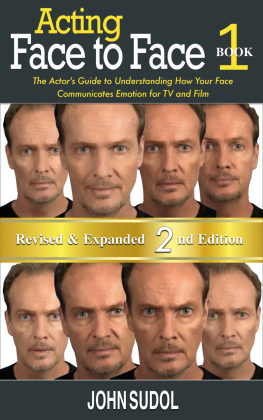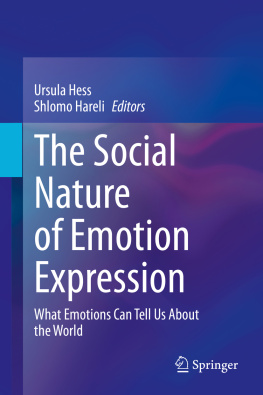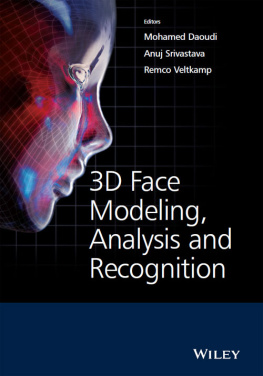Ekman Paul - Unmasking the Face
Here you can read online Ekman Paul - Unmasking the Face full text of the book (entire story) in english for free. Download pdf and epub, get meaning, cover and reviews about this ebook. City: Cambridge;MA, year: 2003, publisher: Institute for the Study of Human Knowledge;Malor Books, genre: Religion. Description of the work, (preface) as well as reviews are available. Best literature library LitArk.com created for fans of good reading and offers a wide selection of genres:
Romance novel
Science fiction
Adventure
Detective
Science
History
Home and family
Prose
Art
Politics
Computer
Non-fiction
Religion
Business
Children
Humor
Choose a favorite category and find really read worthwhile books. Enjoy immersion in the world of imagination, feel the emotions of the characters or learn something new for yourself, make an fascinating discovery.
- Book:Unmasking the Face
- Author:
- Publisher:Institute for the Study of Human Knowledge;Malor Books
- Genre:
- Year:2003
- City:Cambridge;MA
- Rating:5 / 5
- Favourites:Add to favourites
- Your mark:
- 100
- 1
- 2
- 3
- 4
- 5
Unmasking the Face: summary, description and annotation
We offer to read an annotation, description, summary or preface (depends on what the author of the book "Unmasking the Face" wrote himself). If you haven't found the necessary information about the book — write in the comments, we will try to find it.
The breakthrough research on the facial expression of emotion which explains how to identify basic emotions correctly and how to tell when people try to mask, simulate, or neutralize them. It features several practical exercises.
Unmasking the Face — read online for free the complete book (whole text) full work
Below is the text of the book, divided by pages. System saving the place of the last page read, allows you to conveniently read the book "Unmasking the Face" online for free, without having to search again every time where you left off. Put a bookmark, and you can go to the page where you finished reading at any time.
Font size:
Interval:
Bookmark:
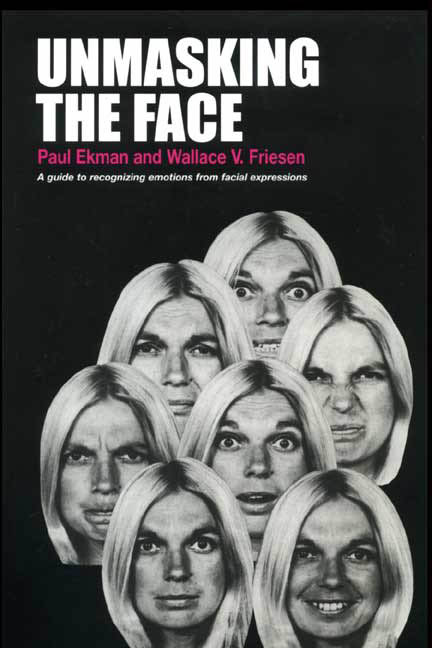
Paul Ekman is a professor of psychology in the department of psychiatry at the University of California Medical School, San Francisco. An expert on expression, the physiology of emotion, and interpersonal deception, he has received many honors, most notably the Distinguished Scientific Contribution Award of the American Psychological Association, and is the author or editor of thirteen other books. He is a frequent consultant on emotional expression to government agencies such as the FBI, the CIA, and the ATF, to lawyers, judges, and police, and to corporations, including the animation studios Pixar and Industrial Light and Magic. He lives in northern California.
Wallace V. Friesen was Lecturer in Psychology andResearch Psychologist at the University of California at San Francisco, where he worked as a co-investigator with Paul Ekman for many years. He is now at the University of Kentucky where his research focuses on emotion in old age. He has co-authored numerous articles on emotions and longevity in periodicals and journals such as the American Psychologist, Psychiatry, and the Journal of Personality and Social Psychology.
Other books by Paul Ekman:
EMOTIONS REVEALED
NATURE OF EMOTION
TELLING LIES
FACE OF MAN
WHY KIDS LIE
EMOTION IN THE HUMAN FACE:
Guidelines for Research and an Integration of
Findings
DARWIN AND FACIAL EXPRESSION:
A Century of Research in Review
Copyright MALOR BOOKS
Los Altos CA 2003
Copyright 2003 by Paul Ekman
All rights reserved. No part of this work may be reproduced or transmitted in any form or by any means, electronic or mechanical, including photocopying and recording, or by any information storage or retrieval system, except as may be expressly permitted by the 1976 Copyright Act or in writing from the publisher. Requests for permission should be addressed in writing to:
ISHK
P. O. Box 176
Los Altos, CA 94023
Library of Congress Cataloging in Publication Data for previous edition is recorded as follows:
Ekman, Paul.
Unmasking the face.
Includes bibliographies.
1. Facial expression. 1. Friesen, Wallace V., joint author. II. Title.
BF637.C45E38 152.42 74-14544
ISBN 0-13-938183-X
ISBN 0-13-938175-9 (pbk.)
This Malor edition ISBN 1-883536-36-7
V 10 9 8 7 6 5 4 3
For Patricia and Myriam
contents
appendix I
appendix II
appendix III
acknowledgments
We are grateful to the National Institute of Mental Health (NIMH) for making it possible for us to study facial expression and body movement during the last eighteen years. Paul Ekman was able to start our research when he was awarded a predoctoral research fellowship from NIMH from 1955 to 1957. During military service from 1958 to 1960 Ekman and Friesen became research associates, a relationship which was later formalized when Friesen joined the project in 1965. A postdoctoral research fellowship from NIMH made it possible for Ekman to pursue the research from 1960 to 1963. Later, when the pressure of teaching seemed likely to curtail research, a Career Development Award from NIMH to Ekman allowed the team to continue the research from 1966 to 1972. During all these years, at each critical juncture, the late Bert Boothe, director of the Research Fellowship Branch, provided invaluable help, interest, and advice. The Clinical Research Branch of NIMH provided continuous support for our research on facial expression and body movement from 1963 until now (MH 11976-09). Its support allowed us to study mental patients and also has made it possible for us to work together since 1965.
We are also grateful to the Advanced Research Project Agency (ARPA) of the Department of Defense for supporting our studies from 1966 to 1970. Lee Hough, former director of ARPA, convinced us of the importance of studying facial expression and gesture in different cultures. He helped us overcome our reluctance to try to resolve the argument over the possible universality of facial expression and gesture. When we launched our research in a remote area of New Guinea, Rowena Swanson, the monitor of the grant, found ways to solve the administrative and bureaucratic obstacles.
We are grateful to Silvan S. Tomkins for his contagious excitement about facial expression of emotion. He encouraged us to learn how to read faces and to teach others to do so. For the past ten years, Patsy Garlan has been an invaluable help as we have approached that point in each experiment where the results of our work are conveyed to others. She has always had a keen understanding of our research, has worked to make our writing lucid, and has critically examined our ideas and searched for ambiguities and contradictions. We are also grateful to our friends, colleagues, and employees who have been enthusiastic about our studies of the face and our attempts to teach others what we have learned. Randall Harrison, John Bear, Allen Dittmann, and Stuart Miller gave many helpful suggestions about how to present this material in an understandable way. Harriett Lukes not only typed the manuscript, but was an enthusiastic first reader. Nina Honbo helped invaluably in keeping us organized and encouraging the completion of the materials. We cannot thank by name the many people who have worked on the research reported in this book; we are grateful for their fine work and for their extra efforts which gave us the time to write this book.
Our special thanks go to our friends, students, and colleagues who let us show their faces in this book. We hope that you, our readers, get to know them well.
introduction
What This Book Is About
This book is about faces and feelings--your own and those of the people around you. The first focus is on what the feelings look like, in other peoples faces and in your own. Photographs show the facial blueprints, of the major emotions--how surprise, fear, anger, disgust, sadness, and happiness are registered by changes in the forehead, eyebrows, eyelids, cheeks, nose, lips, and chin. Common confusions that plague the recognition of expressions of emotions are clarified by pictures highlighting the differences between surprise and fear, anger and disgust, sadness and fear. The subtleties of facial expressions of emotion are revealed in pictures that show the family of expressions for each feeling. Surprise, for example, is an emotion with a big family. There is not one surprise facial expression, but many--questioning surprise, dumbfounded surprise, dazed surprise, slight, moderate, and extreme surprise. The complexities of facial expressions are shown in photographs of how different emotions can blend into a single facial expression to show sad-angry expressions, angry-afraid expressions, surprise-fearful expressions, and so forth.
You can use this information about the blueprints of facial expression to better understand the feelings of others, even when they are trying not to reveal their feelings (Chapter 11 on Facial Deceit). Or you can use the knowledge of the blueprints of facial expression to learn about your own face, to become more aware of what your face is telling you about how you feel and what your face is telling others. Chapter 12, Checking Your Own Facial Expressions, describes how you can determine whether your facial expressions are characterized by a particular style. For example, are you a facial withholder (never showing anything on your face), an unwitting expressor (not knowing you are showing a feeling when you do so), or a substitute expressor (thinking you are showing an angry face when, in fact, you look sad)?
The blueprints of facial expression, whether used to understand others or yourself, are then the first focus of this book. The second focus is the feelings themselves. Although everyone uses the terms anger, fear, sadness, etc., few people really understand fully their own experience of these emotions. For example, what is it really like to be afraid? What does it feel like in your body? What situations make you afraid? Can you always anticipate when you will be afraid? Can you be both afraid and angry at the same time? When you are afraid, do you get aggressive, withdrawn, or thoughtful? Do you laugh fear off, or do you break out in hives? Do you ever enjoy being afraid--watching a horror movie, for example? Do other people react the same way you do when they are afraid? Does the same thing happen to their breathing? Do the same situations that make you afraid make others afraid? Or do you sometimes think or say, I cant understand why he was afraid; that wouldnt bother me or I cant understand why she wasnt afraid; I was terrified.
Next pageFont size:
Interval:
Bookmark:
Similar books «Unmasking the Face»
Look at similar books to Unmasking the Face. We have selected literature similar in name and meaning in the hope of providing readers with more options to find new, interesting, not yet read works.
Discussion, reviews of the book Unmasking the Face and just readers' own opinions. Leave your comments, write what you think about the work, its meaning or the main characters. Specify what exactly you liked and what you didn't like, and why you think so.

